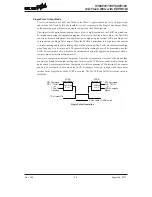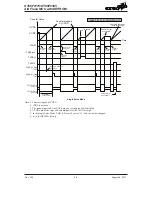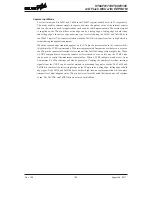
Rev. 1.50
106
����st ��� �01�
Rev. 1.50
10�
����st ��� �01�
HT66F0175/HT66F0185
A/D Flash MCU with EEPROM
HT66F0175/HT66F0185
A/D Flash MCU with EEPROM
TMnC1 Register
Bit
7
6
5
4
3
2
1
0
Name
TnM1
TnM0
TnIO1
TnIO0
TnOC
TnPOL TnC�PTS TnCCLR
R/W
R/W
R/W
R/W
R/W
R/W
R/W
R/W
R/W
POR
0
0
0
0
0
0
0
0
Bit 7~6
TnM1~TnM0
: Select TMn Operating Mode
00: Compare Match Output Mode
01: Capture Input Mode
10: PWM Mode or Single Pulse Output Mode
11: Timer/Counter Mode
These bits setup the required operating mode for the TMn. To ensure reliable operation
the TMn should be switched off before any changes are made to the TnM1 and TnM0
bits. In the Timer/Counter Mode, the TMn output pin control will be disabled.
Bit 5~4
TnIO1~TnIO0
: Select TPn output function
Compare Match Output Mode
00: No change
01: Output low
10: Output high
11: Toggle output
PWM Output Mode/Single Pulse Output Mode
00: PWM output inactive state
01: PWM output active state
10: PWM output
11: Single Pulse Output
Capture Input Mode
00: Input capture at rising edge of TPn or TCKn
01: Input capture at falling edge of TPn or TCKn
10: Input capture at rising/falling edge of TPn or TCKn
11: Input capture disabled
Timer/Counter Mode
Unused
These two bits are used to determine how the TMn output pin changes state when a
certain condition is reached. The function that these bits select depends upon in which
mode the TMn is running.
In the Compare Match Output Mode, the TnIO1 and TnIO0 bits determine how the
TMn output pin changes state when a compare match occurs from the Comparator A.
The TMn output pin can be setup to switch high, switch low or to toggle its present
state when a compare match occurs from the Comparator A. When the bits are both
zero, then no change will take place on the output. The initial value of the TMn output
pin should be setup using the TnOC bit in the TMnC1 register. Note that the output
level requested by the TnIO1 and TnIO0 bits must be different from the initial value
setup using the TnOC bit otherwise no change will occur on the TMn output pin when
a compare match occurs. After the TMn output pin changes state, it can be reset to its
initial level by changing the level of the TnON bit from low to high.
In the PWM Mode, the TnIO1 and TnIO0 bits determine how the TMn output pin
changes state when a certain compare match condition occurs. The TMn output
function is modified by changing these two bits. It is necessary to only change the
values of the TnIO1 and TnIO0 bits only after the TMn has been switched off.
Unpredictable PWM outputs will occur if the TnIO1 and TnIO0 bits are changed when
the TMn is running.
















































